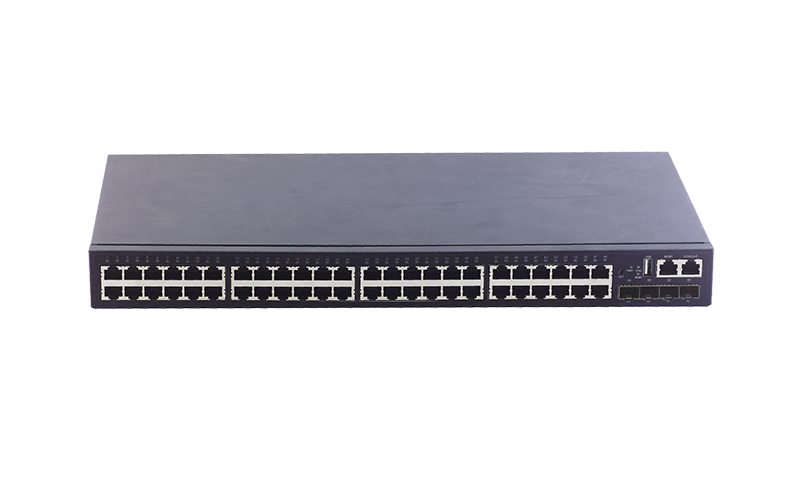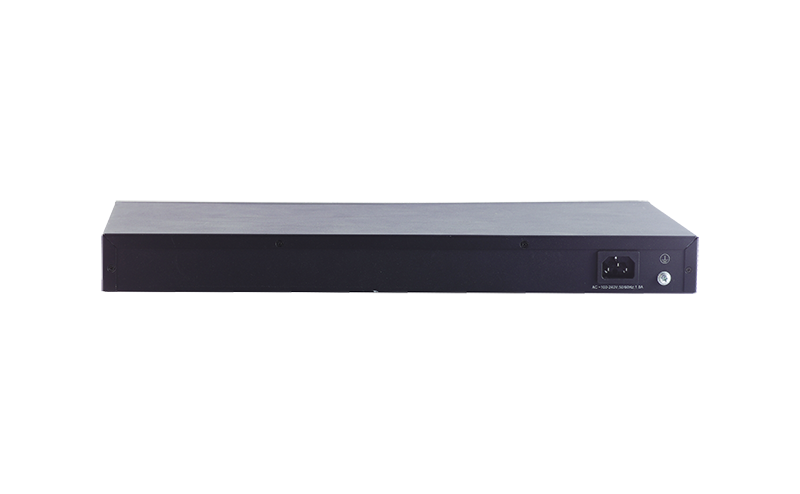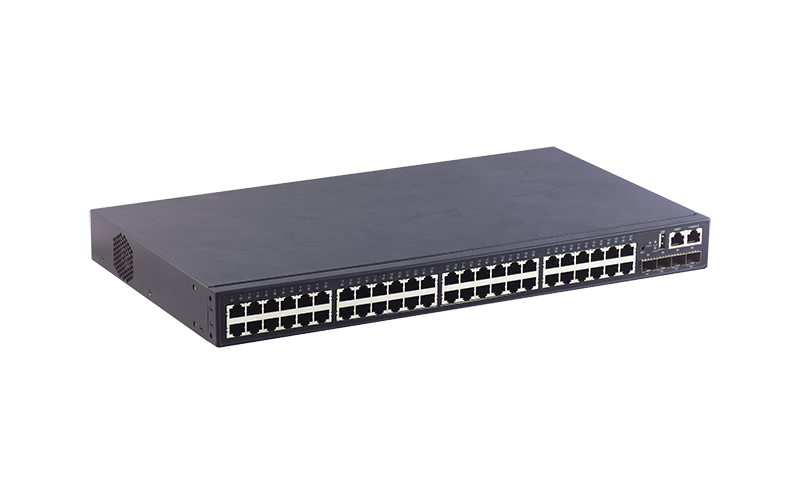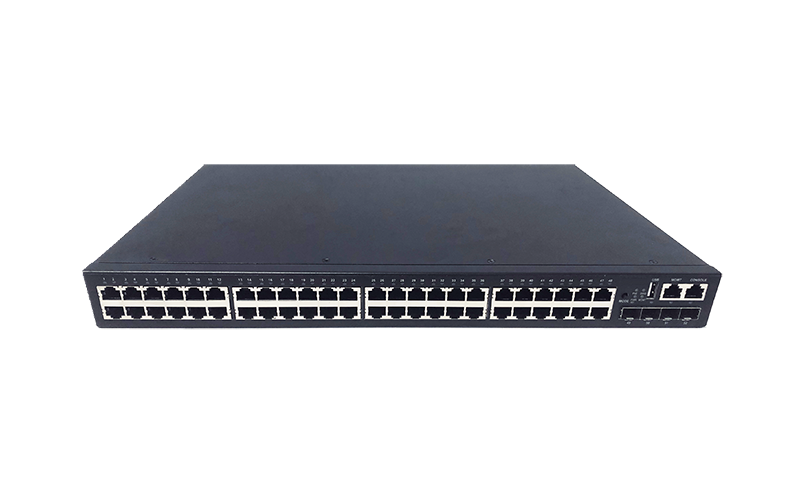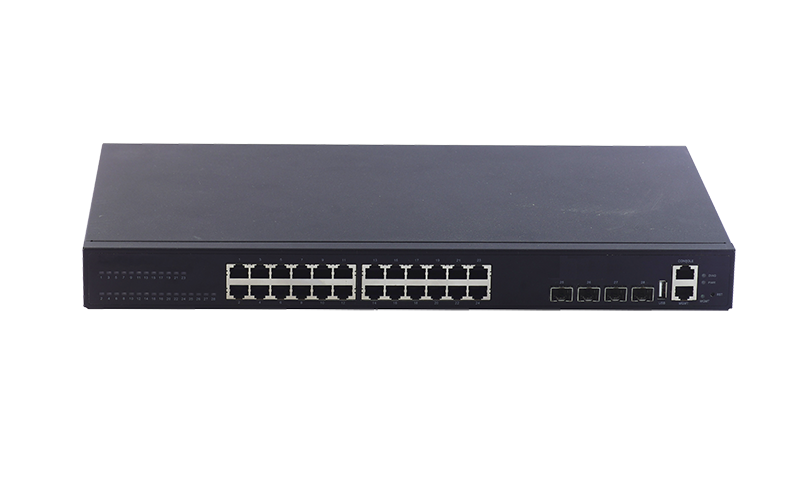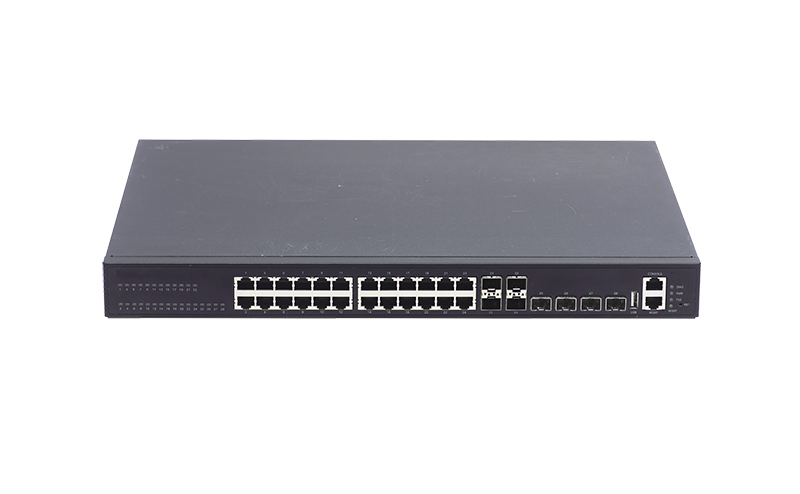- Description
- Specifications
- Dimensions
- Applications
- Package
- Download
- Related Video
- Related Product
OVERVIEW
This series of switches is enterprise-class stackable routing switch with fixed, built-in 10GbE uplink ports. It has great performance on availability, scalability, security and energy efficiency. This fully managed switch provides high switching capacity, supports wire-speed L2/L3 forwarding and high routing performance for IPv4 and IPv6 protocols. Thanks to the VSF (Virtual Switch Framework), the management work for the network administrator is simplified. Multiple switches can be virtualized into one logical device, achieving the sharing of information and data tables between different switches, which provides more reliability. It delivers high-performance, hardware-based on IP routing. RIP, OSPF, and BGP provide dynamic routing by exchanging routing information with other Layer 3 switches and routers. It is ideal for aggregation or access layer for campus, enterprise, government and internet service provider networks.
FEATURES AND HIGHLIGHTS
Abundant Interfaces
UTP5628S-L3(V2): 24*10/100/1000 Base-T RJ-45 ports
UTP5628S-PSB-L3: 20*10/100/1000 Base-T PoE+ RJ-45 ports + 4*1000Mbps Combo (RJ-45/SFP)
UTP5652S-L3(V2): 48*10/100/1000 Base-T RJ-45 ports
UTP5652S-PSB-L3: 48*10/100/1000 Base-T PoE+ RJ-45 ports
• 4*10GBase-X SFP+ ports
• 1*RJ-45 Ethernet Management port
• 1*Console port
• 1*Reset port
• 1*USB2.0 interface
Layer 3 Features
• RIPv1/v2
• OSPFv2/v3
• BGP4/BGP4+
• VRRP
• IGMP
• IPv6 Support
Layer 2 Features
• 802.1Q VLAN
• QoS
• STP/RSTP/MSTP
• ERPS
• IGMP snooping
• LACP
• LLDP
VSF (Virtual Switch Framework)
Virtual Switch Framework can virtualize multiple switches into one logical device, achieving the sharing of information and data tables between different switches.

This series of switches is an enterprise-class stackable routing switch with fixed, built-in 10GbE uplink ports. It has great performance on availability, scalability, security, and energy efficiency. This fully managed switch provides high switching capacity, supports wire-speed L2/L3 forwarding, and high routing performance for IPv4 and IPv6 protocols.
Thanks to the VSF (Virtual Switch Framework), the management work for the network administrator is simplified. Multiple switches can be virtualized into one logical device, achieving the sharing of information and data tables between different switches, which provides more reliability. It delivers high-performance and hardware based on IP routing. RIP, OSPF, and BGP provide dynamic routing by exchanging routing information with other Layer 3 switches and routers. It is ideal for aggregation or access layers for campus, enterprise, government, and internet service provider networks.

● High Port Density with Flexible Expansion Capability
This series of switches are high port density, providing 24/48 Gigabit downlink ports and 4 10GbE SFP+ ports. They support wire-speed forwarding with powerful forwarding capability. At the same time, the uplink 10GbE ports can provide flexible expansion capability and can be used as aggregation switches in the system to address different needs, such as storage, backup, and long-distance transmission. What’s more, the switches provide 1*USB 2.0 interfaces to support local updates for software, avoiding device crashes caused by power failure during web upgrades.

● Abundant L2/L3 Management Function
Support static routing, RIP, OSPF, IPv6, QoS, SNMP, VLAN, multicast, etc.

>>> RIP and OSPF
With the dynamic routing function of RIP (Routing Information Protocol) and OSPF (Open Shortest Path First), the switch solves the routing problem of large and medium complex networks after subnet subdivision and simplifies network configuration.

>>> PBR
With the switch, customers could achieve Policy-based Route (PBR) easily, which plays an important role when they need a multi-exit application and provides application experience for the customer.

>>> Abundant IPv6/IPv4
Support IPv6/IPv4 switching and routing based on hardware for maximum performance. With the increased number of network devices growing, the need for larger addressing and higher security becomes critical. It will be the right product to meet this requirement.

● VSF Stackable Design (Virtual Switch Framework)
The series supports VSF stacking technology which virtualizes multiple switches into a single large one, achieving the sharing of information and data tables between different switches. The performance and port density of the virtualized device is greatly enlarged by times under VSF. VSF also simplifies management work for the network administrator and provides more reliability.

● Unparalleled Manageability
Support rich management interfaces, such as Console, RJ-45 Ethernet port, USB interface, SNMPv1/V2/v3, CLI, TELNET and FTP configuration, etc., to make device management more convenient, and support SSHv1/v2, SSL and other encryption methods, making management more secure.




Non-PoE
● 24*GE + 4*10GE SFP+
● L3 management
● VSF stacking
● IPv6
● 48*GE + 4*10GE SFP+
● L3 management
● VSF stacking
● IPv6
PoE
● 20*GE PoE + 4*GE Combo (RJ-45/SFP) + 4*10GE SFP+
● IEEE 802.3af/at
● PoE budget: 370W
● L3 management
● VSF stacking
● IPv6
● 48*GE PoE + 4*10GE SFP+
● IEEE 802.3af/at
● PoE budget: 740W
● L3 management
● VSF stacking
● IPv6
Full Fiber
● 16*GE SFP + 8*GE Combo (RJ-45/SFP) + 4*10GE SFP+
● AC/DC redundant power supply
● L3 management
● VSF stacking
● IPv6
|
Items |
UTP5652S-L3(V2) |
UTP5652S-PSB-L3 |
|
Hardware Specifications |
||
|
Downlink Port |
48*10/100/1000BASE-T RJ-45 ports |
48*10/100/1000BASE-T PoE+ RJ-45 ports |
|
Uplink Port |
4*1/10GBASE-X SFP+ |
|
|
Management Port |
1* RJ-45 Ethernet management port |
|
|
1* Console port |
||
|
1* Reset port |
||
|
1* USB2.0 interface |
||
|
Cable |
Cat5 or better |
|
|
Dimensions (W*D*H) |
440mm*240mm*44mm |
440mm*320mm*44mm |
|
Single Package Weight |
4.25kg |
7.235kg |
|
Single Package Dimensions |
530mm*322mm*98mm |
555mm*483mm*168mm |
|
Power Supply |
AC: 100~240VAC, 50~60Hz |
AC: 100~240VAC, 50~60Hz |
|
|
DC: -52V~-57V |
|
|
Power Consumption |
<50W(Full load) |
<897W(Full load, include PoE) |
|
Material |
Metal shell |
|
|
Switch Property |
||
|
Forwarding Modes |
Store and Forward |
|
|
Switching Capacity |
176Gbps, non-blocking |
|
|
Packet Forwarding Rate |
131Mpps |
|
|
Jumbo frame |
10K |
|
|
MAC Table |
16K, supported auto learning |
|
|
ARP Table |
4K |
512 |
|
Routing Table |
1K |
512 |
|
ACL Table |
1K |
512 |
|
PoE |
||
|
PoE Standard |
N/A |
IEEE 802.3af/at |
|
PoE Budget |
N/A |
30W max for each port, 740W max for whole switch |
|
Environments |
||
|
Operating |
Temperature: 0℃~50℃ |
|
|
Relative Humidity: 10%~90% (Non-condensation) |
||
|
Storage |
Temperature: -40℃~70℃ |
|
|
Relative Humidity: 10%~95% (Non-condensation) |
||
|
ESD |
Contact Discharge: ±8kV, Air Discharge: ±15kV |
|
|
Surge |
±6kV |
|
|
Software Architecture |
||
|
Main Features |
||
|
L1, L2 Features |
||
|
L1 Standard |
IEEE 802.3(10BASE-T), IEEE 802.3u(100BASE-TX), IEEE 802.3z(1000BASE-X), IEEE 802.3ab(1000BASE-T), IEEE 802.3ae(10GBase), IEEE 802.3x, IEEE 802.3ak(10GBASE-CX4) |
|
|
LLDP & LACP |
Port loopback detection |
|
|
LLDP and LLDP-MED |
||
|
ULDP |
||
|
802.3ad LACP, max 128 group trunks with max 8 ports for each trunk(UTP5652S-PSB-L3 supports max 64 group trunks with max 8 ports for each trunk ) |
||
|
LACP load balance |
||
|
ERPS (G.8032) |
||
|
Mirroring |
N:1 Port Mirroring |
|
|
RSPAN |
||
|
Spanning Tree |
IEEE 802.1D(STP) |
|
|
IEEE 802.1w(RSTP) |
||
|
IEEE 802.1s(MSTP) |
||
|
Root Guard |
||
|
BPDU Guard |
||
|
BPDU Tunnel |
||
|
VLAN |
802.1Q, 4K VLAN |
|
|
MAC VLAN, Voice VLAN, PVLAN, Protocol VLAN, Multicast VLAN |
||
|
QinQ, Flexible QinQ |
||
|
GVRP |
||
|
N:1 VLAN Translation |
||
|
Broadcast / Multicast / Unicast Storm Control |
||
|
IGMP |
IGMP v1/v2/v3 Snooping and L2 Query |
|
|
ND Snooping |
||
|
MLDv1/v2 Snooping |
||
|
Security |
Port Security |
|
|
Port Configure |
Flow Control: HOL, IEEE 802.3x |
|
|
Bandwidth Control |
||
|
L3 Features |
||
|
IP Routing |
Static Routing, RIPv1/v2, OSPFv2, BGP4, OSPFv3, BGP4+ |
|
|
OSPF multiple processes |
||
|
LPM Routing |
||
|
Policy-based routing (PBR) for IPv4 and IPv6 |
||
|
VRRP |
||
|
URPF |
||
|
ECMP |
||
|
BFD |
||
|
IGMP |
IGMP v1/v2/v3, IGMP Proxy |
|
|
Static Multicast Route |
||
|
Multicast Receive Control |
||
|
Illegal Multicast Source Detect |
||
|
ARP |
ARP Guard, Local ARP proxy, Proxy ARP, ARP Binding, Gratuitous ARP, ARP Limit |
|
|
Anti ARP Cheat, Anti ARP Scan |
||
|
DNS |
DNS Client, DNS Relay |
|
|
GRE |
GRE Tunnel(UTP5652S-PSB-L3 doesn’t support) |
|
|
Advanced Configure |
||
|
IPv6 |
6to4 Tunnel, Configured Tunnel, ISATAP Tunnel, GRE Tunnel(UTP5652S-PSB-L3 doesn’t support) |
|
|
ICMPv6, ND, DNSv6 |
||
|
IPv6 LPM Routing, IPv6 Policy-based Routing (PBR) |
||
|
IPv6 VRRPv3, IPv6 URPF, IPv6 RA |
||
|
RIPng, OSPFv3, BGP4+ |
||
|
MLD Snooping, IPv6 Multicast VLAN |
||
|
MLDv1/v2, IPv6 ACL, IPv6 QoS |
||
|
QoS |
8 Queues |
|
|
SP, WDRR, SWDRR |
||
|
Traffic Classification Based on 802.1p CoS, ToS, DiffServ DSCP, ACL, port number |
||
|
Traffic Policing |
||
|
PRI Mark/Remark |
||
|
ACL |
IP ACL, MAC ACL, IP-MAC ACL, User-Defined ACL |
|
|
Standard and Expanded ACL Based on source/destination IP or MAC, IP Protocol, TCP/UDP port, DSCP, ToS, IP Precedence), VLAN, Tag/Untag, CoS |
||
|
Redirect and statistics |
||
|
Rules can be configured to port, VLAN |
||
|
Time Ranged ACL |
||
|
ACL rules can be configured to port, VLAN |
||
|
Security |
802.1x AAA |
|
|
Port, MAC-based authentication |
||
|
Accounting based on time length and traffic |
||
|
Guest VLAN and auto VLAN |
||
|
RADIUS for IPv4 and IPv6 |
||
|
TACACS+ for IPv4 and IPv6 |
||
|
MAB |
||
|
DHCPv4/v6 Traffic Monitor |
DHCP Server/Client for IPv4/IPv6 |
|
|
DHCP Relay/Option 82 |
||
|
DHCP Snooping/Option 82 |
||
|
Traffic Monitor |
sFlow Traffic Analysis |
|
|
Security Network Management |
CLI, WEB, Telnet, SNMPv1/v2c/v3 through IPv4 and IPv6 |
|
|
Syslog and external Syslog Server |
||
|
HTTP SSL |
||
|
SNMP MIB, SNMP TRAP |
||
|
FTP/TFTP |
||
|
SNTP/NTP |
||
|
RMOM 1,2,3,9 |
||
|
Authentication by Radius/TACACS |
||
|
SSH v1/v2 |
||
|
Dual firmware images/ Configuration files |
||
|
802.3ah OAM, 802.1ag OAM |
||
|
Data Center Features |
VSF (Virtual Switch Framework), up to 4 stack members |
|
 PoE Switch and Industrial switch Manufacturer
PoE Switch and Industrial switch Manufacturer












